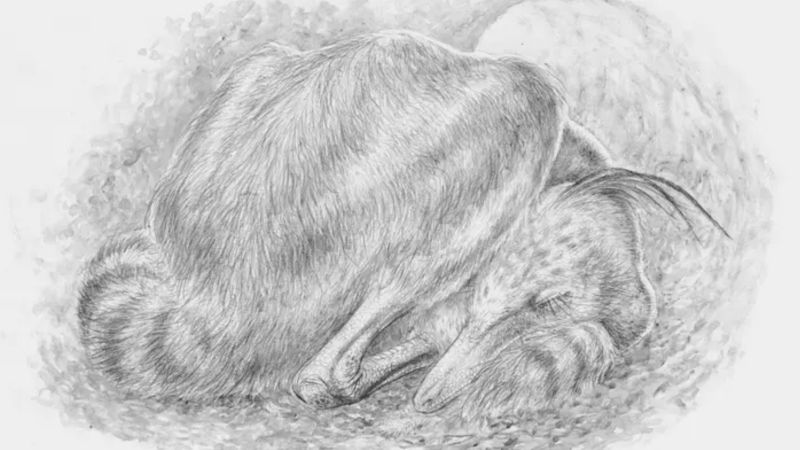Join CNN’s Surprise Concept science e-newsletter. Explore the universe with news on fascinating discoveries, scientific advancements and more.
CNN
—
Demise within the wild is commonly brutal and violent. However for one small, birdlike dinosaur within the late Cretaceous Interval, the tip of its life was comparatively peaceable — it curled as much as take a nap and by no means awoke.
That’s what scientists have interpreted from the pose of the dinosaur’s fossil skeleton. With the creature’s head tucked over its limbs and tail snugly wrapped round its physique, its cozy posture resembled these of modern birds at relaxation, hinting that these dinosaurs didn’t simply appear to be birds — they might have behaved like them, too.
Paleontologists excavated the dinosaur’s cranium and practically full skeleton within the Gobi Desert on the Barun Goyot Formation in Mongolia, and a lot of the bones had been nonetheless organized within the animal’s authentic dying pose, researchers reported Wednesday within the journal PLOS One.
The animal’s lengthy neck wrapped round the proper facet of its trunk, and its head was tucked near its facet, resting atop the proper knee. The hind limbs had been folded beneath it, and a lot of the tail curved across the physique’s left facet.
The examine authors recognized it as an alvarezsaurid, a sort of small theropod (bipedal meat-eating dinosaur) with a protracted tail and legs and quick entrance limbs. Alvarezsaurids are half of a bigger dinosaur group referred to as maniraptorans, which incorporates birds and birdlike dinosaurs that had been their closest kin.
The small alvarezsaur’s posture emulated that of two different dinosaur fossils present in Mongolia that had been additionally curled up in birdlike sleeping poses: Sinornithoides youngi and Mei lengthy. These two are troodontids, one other kind of dinosaur within the maniraptoran group, and one which’s extra carefully associated to birds than alvarezsaurs had been.

The brand new fossil means that this sleeping conduct could have been extra widespread than anticipated among the many non-avian kin of the earliest birds, the researchers reported.
“We’ve all seen geese sleeping with their heads tucked below their wings. And then you definately see this little dinosaur with the very same sleeping posture,” mentioned paleontologist Dr. Jingmai O’Connor, affiliate curator of fossil reptiles on the Subject Museum of Pure Historical past in Chicago.
“That is tangible proof of behaviors which are right now distinctive amongst birds. Now, we are able to really say this isn’t a uniquely avian characteristic,” O’Connor, who was not concerned within the examine, advised CNN.
The scientists who examined the fossil decided it was a species new to science and gave it a fierce title: Jaculinykus yaruui. The genus title comes from Jaculus, a legendary dragon, and onykus, which suggests claw in historic Greek, whereas its species title originates from yaruu, the Mongolian phrase for hasty or speedy.
Jaculinykus yaruui lived round 70 million years in the past towards the tip of the Cretaceous Period (about 145 million to 66 million years in the past) and would have measured simply over 3 toes (1 meter) lengthy from nostril to tail tip, mentioned lead examine writer and paleontologist Kohta Kubo, a doctoral candidate within the Paleobiology Analysis Group at Hokkaido College in Japan.
“This specimen was thought of a partial skeleton when it was found, however after its preparation, it represents a virtually full and articulated skeleton preserving its life posture,” Kubo advised CNN in an electronic mail. “It’s the first definitive file of this posture in alvarezsaurs in addition to early branching maniraptoran dinosaurs.”
Jaculinykus yaruui’s closest relative is a tiny alvarezsaurid named Shuvuuia deserti, Kubo mentioned. Among the many options that set it aside are the form of its nostrils, the attachment of jaw muscle tissue within the cranium, and the shapes of its limb bones.
“It’s a pleasant specimen, and it’s all the time thrilling to have new dinosaur variety, particularly within the alvarezsaurids,” O’Connor mentioned.
Alvarezsaurids aren’t the best-known dinosaur group, however they’ve lengthy fascinated scientists with their drastically shortened forearms and fingers, which in some species terminate in a single huge finger sprouting a claw like a spike.
“All these fossils which are so well-preserved that they file behaviors are extremely uncommon,” O’Connor mentioned. “It’s nice to have some extra proof that positively reveals that this sleeping posture was extra widespread.”
In fashionable birds, such conduct helps them to preserve physique warmth; it doubtless served the same goal for maniraptoran dinosaurs that additionally curled up at bedtime, in line with the examine. Over the course of their evolution, alvarezsaurs shrank in measurement. This “drastic miniaturization” could have led the non-avian dinosaurs to undertake the identical thermoregulatory technique utilized by their avian cousins, Kobu mentioned.
What’s extra, sleepy little Jaculinykus yaruui “highlights that this avian-like thermoregulatory conduct advanced previous to the origin of powered flight,” he added. “Jaculinykus is a crucial instance that alvarezsaurids possess extra similarities with residing birds — not solely in osteological options but in addition behavioral traits.”
Mindy Weisberger is a science author and media producer whose work has appeared in Reside Science, Scientific American and How It Works journal.

